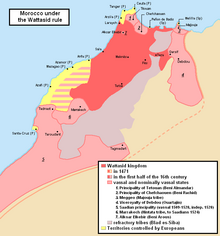Principality of Debdou
| Principality of Debdou Imarat Debdou | |
|---|---|
| Former subdivision of Morocco | |
| 1430–1563 | |
 Map of Morocco c. 1515, showing the location of the Ouartajin principality | |
| Capital | Debdou |
| History | |
| History | |
• Established | 1430 |
• Disestablished | 1563 |
| Today part of | Morocco |
The Principality of Debdou was an autonomous hereditary viceroyalty that existed in eastern Morocco from 1430 to 1563, with its capital at Debdou. It was governed by the Ouartajin, a dynasty of Berber descent, related to the Marinids and the Wattasids.[1][2]
History[]
The Principality of Debdou was first established in 1430 as a governorate of Morocco, then ruled by the Marinid dynasty. By the second half of the 15th century, the Ouartajin gained more autonomy towards Fez as Marinids lost their prestige and most of their power to Wattasid viziers. The principality became fully autonomous when Muhammad ibn Ahmed was appointed viceroy of Debdou by Wattasid sultan Muhammad ibn Yahya (r. 1472-1504).
During the last years of the reign of Muhammad II, the Principality of Debdou became a tributary state of the Saadians. In 1563, Saadian ruler Abdallah al-Ghalib overthrew the Ouartajin and made Debdou a fully dependent Pashalik of Morocco.
List of Ouartajin princes[]
- Musa ibn Hammu (1430-1460), appointed governor of Debdou ;
- Ahmad ibn Musa (1460-1485) ;
- Muhammad ibn Ahmad (1485-1515), appointed viceroy of Debdou ;
- Muhammad II (1515-1550), became tributary of the Saadians ;
- Ammar (1550-1563).
References[]
- States and territories established in 1430
- States and territories disestablished in 1563
- Former subdivisions of Morocco